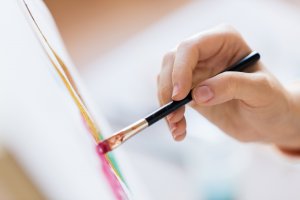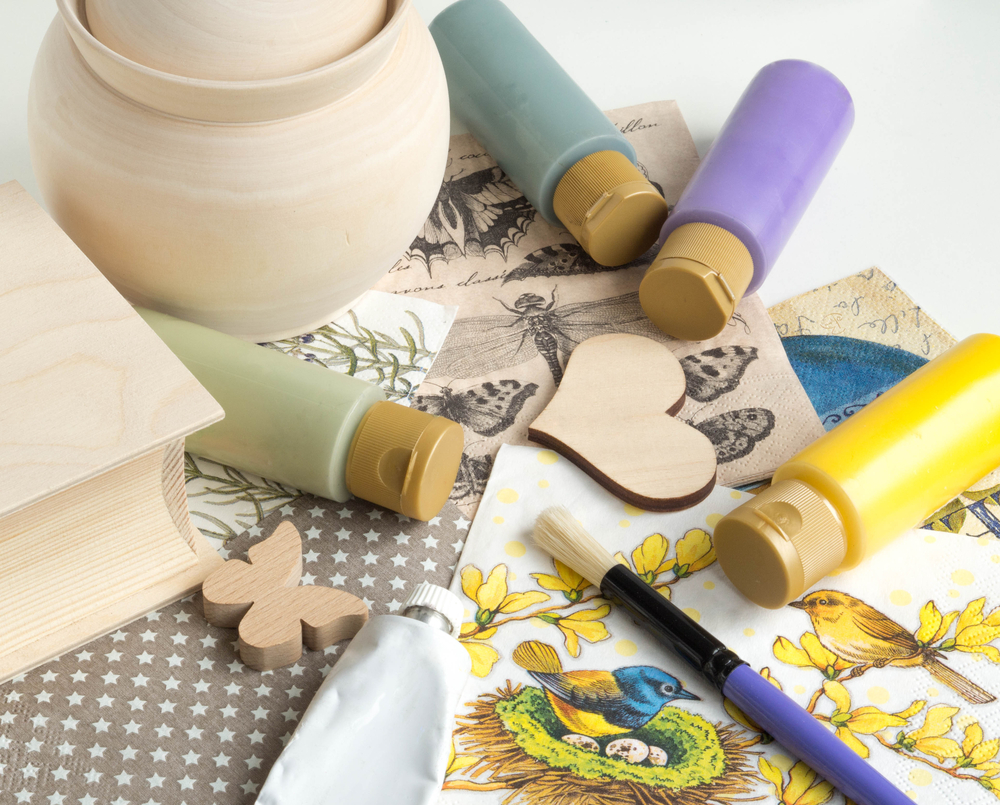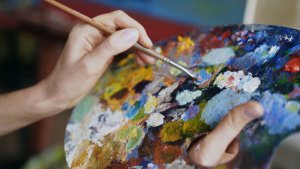8 Types of Paint Brush Every Artist Should Have

After much consideration, you’ve decided to paint a picture… Congratulations! Now it’s time to go out and buy all the materials you need to create the perfect work of art. When you go to the arts and crafts store, you’ll realize there are a lot of different options to choose from. To begin with, there are hundreds of different types of paint brushes. What are they all for? Find out in the following article.
Paint brushes: characteristics
Along with the type of paint, the paint brushes you choose can be key in determining whether or not your painting is a success. Of course, there are lots of other factors, but there’s no denying that the shape, size, and material of your brushes will give completely different results.
If you’ve recently picked up this wonderful hobby, one of the first things you need to know is what brushes actually consist of. Basically, they consist of three distinct parts:
1. Bristles: these might be made from natural hair (pig, goat, pine marten, squirrel) or synthetic materials (nylon or polyester).
2. Ferrule: a metal ring which attaches the bristles to the handle. It might be made from aluminum or stainless steel.
3. Handle: it might be made from wood or plastic and can be of varying lengths and widths. The width will depend on the number of bristles.

Types of brushes
To start off with, you can simply buy a set of assorted paint brushes of all different shapes and sizes. That way, you’ll have a variety of different sizes to work with and you’ll be able to create exactly the brush strokes you’re after. If, for example, you want to do a particularly detailed and realistic painting, you need to choose softer, finer paint brushes.
If your painting is less detailed and features larger brush strokes, it’s best to choose larger brushes. The most common types of brushes are:
1. Rigger brushes
These brushes are used to paint particularly fine lines and are perfect for small details, curves, faces, etc.
2. Round brushes
This is one of the most common brushes for painting larger details and thicker lines. There are lots of different types, with some more pointed than others. If you want to know if it’s a good quality brush, put it in water and leave it to dry. The bristles shouldn’t split or bend.
3. Angle brush
The bristles of this paint brush are longer on one side than the other, forming a diagonal slant. They are mainly used for creating irregular shapes such as flower petals. You can also use them for painting surfaces with greater precision.

4. Flat brush
Unlike the last brush we looked at, all the bristles in this brush are the same length and width. The flat brush is used for spreading oil paint on the canvas, mixing colors, creating square brush strokes, or painting thick lines (or thin ones if you hold it sideways).
5. Rake brush
At first glance, you might think it’s just a simple flat brush, but in reality, it has a mixture of short and long bristles. It’s normally used for painting feathers, animal fur, grass etc.
6. Cat’s tongue brush
This brush is a mixture of two different types of brushes: the round brush and the flat brush. The center is flat, and and the bristles at the ends are shorter and curve towards the center. The good thing about the cat’s tongue brush is that it’s very versatile. You can use it for contouring, painting fine details (like petals) and for mixing colors.
7. Mop brush
This type of brush great for blending and for softening the transition from one color to another to make it less obvious. It’s similar to make up brushes.

8. Fan brush
The last brush in this list is one of the best-known paint brushes of all. It’s easy to use and to clean. It’s great for painting foliage, clouds, textures or grass, and even for blending.
You don’t need to every single type of brush in the store. It all depends on the paint and techniques you use. In any case, to help your brushes last longer, we recommend that you clean them thoroughly as soon as you finish using them and leave them hanging them upside down to let them dry naturally. If you actively try to dry them off yourself with a cloth or something, all you’ll do is warp the bristles so that they’ll soon be unusable.
After much consideration, you’ve decided to paint a picture… Congratulations! Now it’s time to go out and buy all the materials you need to create the perfect work of art. When you go to the arts and crafts store, you’ll realize there are a lot of different options to choose from. To begin with, there are hundreds of different types of paint brushes. What are they all for? Find out in the following article.
Paint brushes: characteristics
Along with the type of paint, the paint brushes you choose can be key in determining whether or not your painting is a success. Of course, there are lots of other factors, but there’s no denying that the shape, size, and material of your brushes will give completely different results.
If you’ve recently picked up this wonderful hobby, one of the first things you need to know is what brushes actually consist of. Basically, they consist of three distinct parts:
1. Bristles: these might be made from natural hair (pig, goat, pine marten, squirrel) or synthetic materials (nylon or polyester).
2. Ferrule: a metal ring which attaches the bristles to the handle. It might be made from aluminum or stainless steel.
3. Handle: it might be made from wood or plastic and can be of varying lengths and widths. The width will depend on the number of bristles.

Types of brushes
To start off with, you can simply buy a set of assorted paint brushes of all different shapes and sizes. That way, you’ll have a variety of different sizes to work with and you’ll be able to create exactly the brush strokes you’re after. If, for example, you want to do a particularly detailed and realistic painting, you need to choose softer, finer paint brushes.
If your painting is less detailed and features larger brush strokes, it’s best to choose larger brushes. The most common types of brushes are:
1. Rigger brushes
These brushes are used to paint particularly fine lines and are perfect for small details, curves, faces, etc.
2. Round brushes
This is one of the most common brushes for painting larger details and thicker lines. There are lots of different types, with some more pointed than others. If you want to know if it’s a good quality brush, put it in water and leave it to dry. The bristles shouldn’t split or bend.
3. Angle brush
The bristles of this paint brush are longer on one side than the other, forming a diagonal slant. They are mainly used for creating irregular shapes such as flower petals. You can also use them for painting surfaces with greater precision.

4. Flat brush
Unlike the last brush we looked at, all the bristles in this brush are the same length and width. The flat brush is used for spreading oil paint on the canvas, mixing colors, creating square brush strokes, or painting thick lines (or thin ones if you hold it sideways).
5. Rake brush
At first glance, you might think it’s just a simple flat brush, but in reality, it has a mixture of short and long bristles. It’s normally used for painting feathers, animal fur, grass etc.
6. Cat’s tongue brush
This brush is a mixture of two different types of brushes: the round brush and the flat brush. The center is flat, and and the bristles at the ends are shorter and curve towards the center. The good thing about the cat’s tongue brush is that it’s very versatile. You can use it for contouring, painting fine details (like petals) and for mixing colors.
7. Mop brush
This type of brush great for blending and for softening the transition from one color to another to make it less obvious. It’s similar to make up brushes.

8. Fan brush
The last brush in this list is one of the best-known paint brushes of all. It’s easy to use and to clean. It’s great for painting foliage, clouds, textures or grass, and even for blending.
You don’t need to every single type of brush in the store. It all depends on the paint and techniques you use. In any case, to help your brushes last longer, we recommend that you clean them thoroughly as soon as you finish using them and leave them hanging them upside down to let them dry naturally. If you actively try to dry them off yourself with a cloth or something, all you’ll do is warp the bristles so that they’ll soon be unusable.







